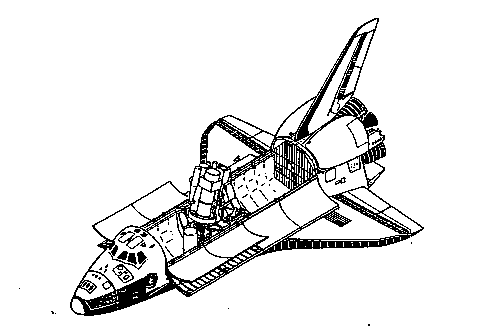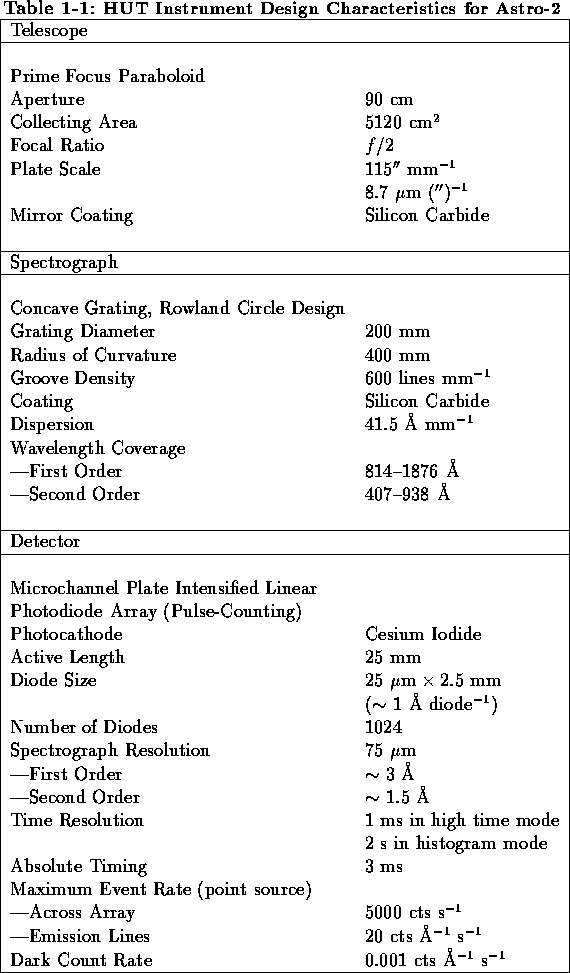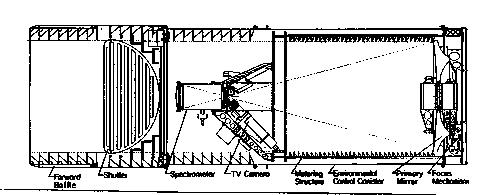 |
The Hopkins Ultraviolet Telescope (HUT) is one of three major instruments that comprise the Astro Observatory. It mounts on the Spacelab Instrument Pointing System (IPS) along with the Ultraviolet Imaging Telescope (UIT) and the Wisconsin Ultraviolet Photo-Polarimeter Experiment (WUPPE). The observatory is attached to the cargo bay of the Space Shuttle on two Spacelab pallets. All three instruments are operated as a single observatory. The Astro Observatory mounted in the Shuttle as it will be configured for Astro-2 is shown in Figure 1-1.

The HUT is an instrument designed for moderate-resolution (R = 300)
spectrophotometry of faint astronomical objects (mv ![]() 6) at far- and
extreme-ultraviolet wavelengths (415-1860 Å) with special emphasis
on the region between Lyman-
6) at far- and
extreme-ultraviolet wavelengths (415-1860 Å) with special emphasis
on the region between Lyman-![]() (1216 Å) and the Lyman limit (912 Å).
Its principal elements are a 90 cm f/2 prime focus telescope, a normal
incidence concave grating spectrograph, a microchannel plate detector,
an integrating SIT vidicon field
acquisition camera, and a dedicated experiment processor (DEP) for instrument
control and data handling, including video processing,
as well as a spectrometer processor (SP) that interfaces with the detector.
Spectra are recorded
in 2048 channels in a pulse-counting mode with a time resolution of 1 msec,
except for the brightest sources where the time resolution is 2 sec. A
conceptual diagram of HUT is given in Figure 1-21 and the instrument
characteristics are summarized in Table 1-1. A description of the performance
and calibration of HUT during the Astro-1 mission is given by Davidsen et al.
(1992).
(1216 Å) and the Lyman limit (912 Å).
Its principal elements are a 90 cm f/2 prime focus telescope, a normal
incidence concave grating spectrograph, a microchannel plate detector,
an integrating SIT vidicon field
acquisition camera, and a dedicated experiment processor (DEP) for instrument
control and data handling, including video processing,
as well as a spectrometer processor (SP) that interfaces with the detector.
Spectra are recorded
in 2048 channels in a pulse-counting mode with a time resolution of 1 msec,
except for the brightest sources where the time resolution is 2 sec. A
conceptual diagram of HUT is given in Figure 1-21 and the instrument
characteristics are summarized in Table 1-1. A description of the performance
and calibration of HUT during the Astro-1 mission is given by Davidsen et al.
(1992).
 |
The HUT interfaces to the Shuttle through the Spacelab avionics. The avionics, which include computers, tape drives, and other electronic components needed for experiment control and data handling, is mounted on two pallets and inside a pressurized container called the Igloo. The Astro telescopes are mounted on a cruciform structure which is attached to the Instrument Pointing System (IPS). The IPS provides a stable pointing platform for the observatory; it is used to acquire and track targets of interest. The Payload Specialist (PS) views target fields imaged by the HUT acquisition camera on the Shuttle TV system. Using this image, a detailed finding chart, and the expected locations of up to three guide stars that are marked in the video image by the HUT DEP, the PS acquires the desired targets. Spectral data and video images are sent to the ground and displayed on the Telemetry Experiment Ground Support Equipment (TEGSE) at the Payload Operations Control Center (POCC) in real time for evaluation by the experimenters. The PS will normally control HUT from the Shuttle aft flight deck, but the experimenters in the POCC can also change instrument parameters and modify observing sequences by uplinking commands.
The instrument consists of two packages: the telescope module (TM), which contains the optics, spectrometer, and detector system within an environmental control canister (ECC); and the electronics module (EM), which contains the two experiment processors (the DEP and the SP) and other electronics necessary for thermal control and mechanism operations. The location of the hardware on the cruciform structure which is used to attach the instruments to the IPS is shown in Figure 1-3. A more detailed description of the hardware, its operation, and calibration will follow.

|